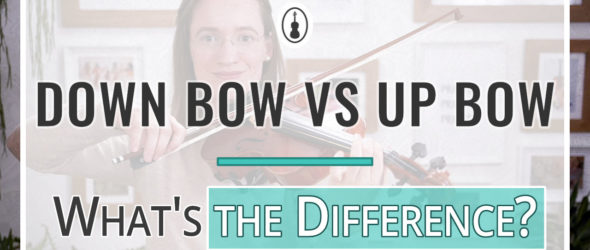Learn the differences between down bow vs up bow on string instruments.
A down bow is a bow stroke that starts at the frog and ends at the tip. An up bow is a stroke that begins at the tip and ends at the frog.
Did you know that the direction of the bow stroke can affect the tone of the notes on the violin?
The two bowing directions, down bow and up bow, will make different sounds on the violin. A down bow usually creates a rounder, warmer, heavier tone; while an up bow might sound brighter, sharper, and lighter.
The bow is in charge of tone production, so bowing is an essential technique to practice and get good at. Read on to learn about bowing from the basics, through the down bow and up bow directions, to the symbols above the notes in your violin sheet music, how to choose bowing direction if there’s no indication, and how to improve your bowing.
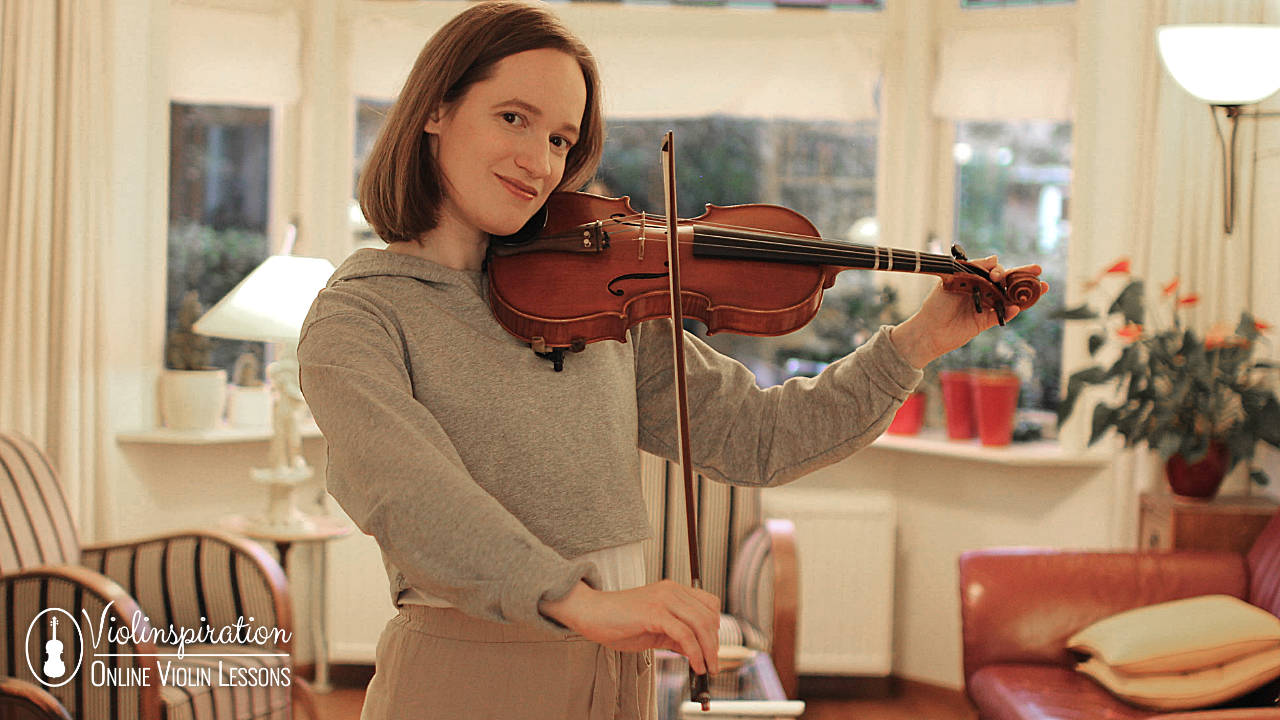
Bowing Basics
We place the bow between the bridge and the end of the fingerboard and draw the bow hair across the strings. The stick (wood part of the bow) faces up to the sky. Ideally, we want to play with flat hair to create a consistent, strong sound.
If you haven’t yet learned how to hold the bow, be sure to study my Bow Grip Guide. It’s very important to hold the bow just right. If your bow hold is a little off, it’s very difficult to perform harder techniques.
What is the Bow Direction?
The bow direction describes which way a violin player pulls the bow across the string. There are two bowing directions: down bow and up bow.
To learn about bow directions, it’ll be helpful to understand the parts of the bow. The frog is the wooden block at one end of the bow. This is where you’ll place your right hand to play. At the other end of the bow is the tip. This is the pointed end of the stick.
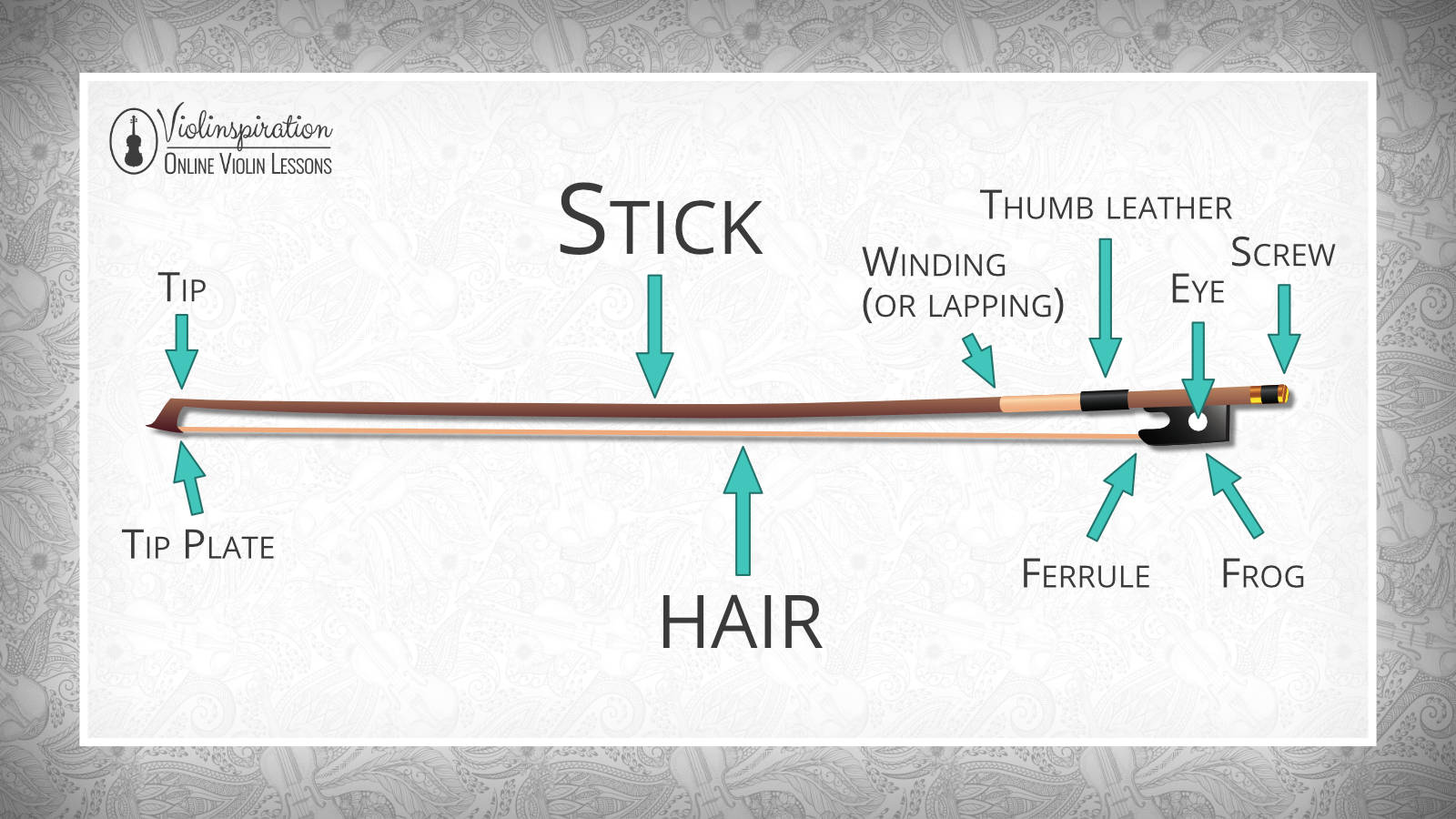
A down bow is played by pulling the bow from the frog to the tip. On the violin and viola, playing a down bow means the bow moves toward the ground. On the cello and double bass, down bows move from left to right from the player’s perspective.
An up bow is played by pulling the bow from the tip to the frog. On upper string instruments (violin & viola), the bow moves towards the ceiling during an up bow stroke. On the lower string instruments (cello and double bass), up bows go from right to left from the player’s point of view.
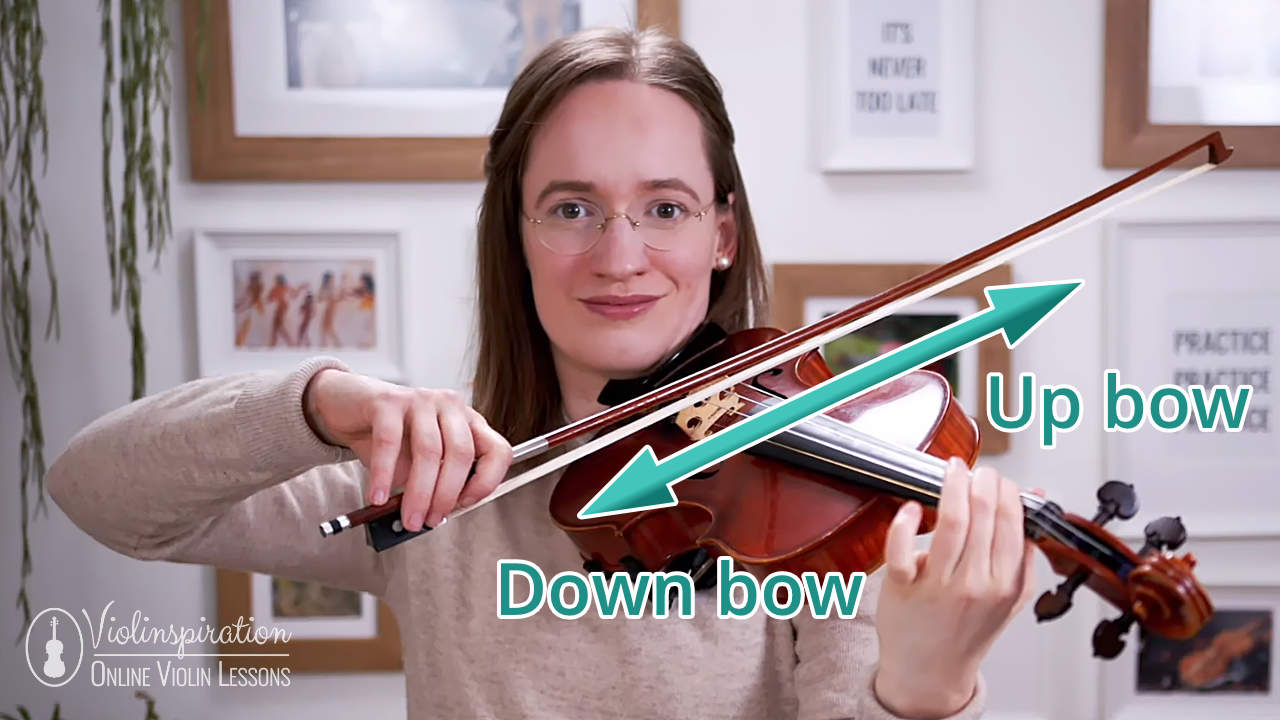
Down Bow vs Up Bow – Difference in the Sound
Let’s have a closer look at how the up bow and down bow affect the sound of the violin.
Down Bows
The down bow stroke works with gravity, so it’ll naturally sound louder than an up bow. There’s also more pressure from the high concentration of weight at the frog.
The frog is heavier than the tip of the bow, and your hand is sitting on the frog. There’s a lot of weight at the start of a down bow which creates a bit of a natural accent.
Up Bows
There’s much less weight at the tip of the bow, and your right hand is far away. This makes the start of an up bow sound quieter, or weaker. As you reach the frog, the up bow usually will naturally get louder.
If you’re playing a crescendo (a dynamic marking that tells us to gradually play louder), it’s helpful to use an up bow since we’re moving from light to heavy. The bow naturally wants to create a crescendo!
How is Bow Direction Notated?
In sheet music, we use one symbol to represent down bows, and another to represent up bows. We don’t want to ignore these bowing directions–they’re actually super important to help the music sound the way we intend.
Down Bow Symbol
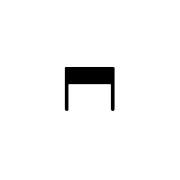
The violin down bow symbol looks somewhat like a bracket and will be written above a note. This tells you to play that specific note down bow (from frog to tip).
Up Bow Symbol
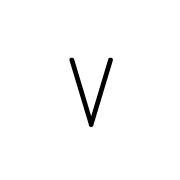
The up bow symbol looks like a V. This symbol indicates that the note it’s written above should be played with the up bow stroke (from tip to frog).
How often will I see bow direction notated?
In most string music, you won’t see bow markings above each and every note. Instead, you might just see one bow mark symbol above the first note of a section of music.
After the first note’s bow direction is notated, you should assume that the bow will move back and forth, alternating the opposite directions between the down bow and the up bow for each note. We usually call this “as it comes.”
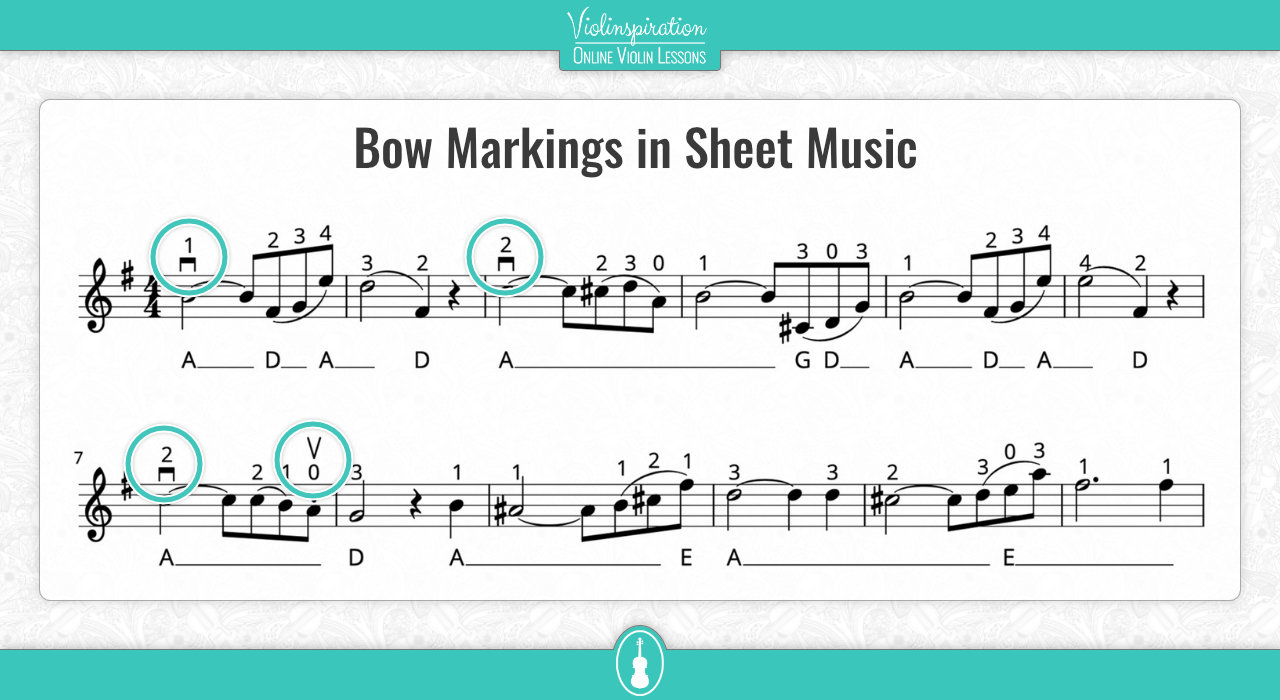
Slurs
A slur is a curved line that connects two or more notes. A slur tells you to play those notes all in one bow direction.
We usually play slurs when we’d like the notes to sound smooth and connected. It can take some time to adjust to the feeling of playing more than one note per bow direction, but once you learn how, you’ll know it for life. This is a very important and useful technique to learn!
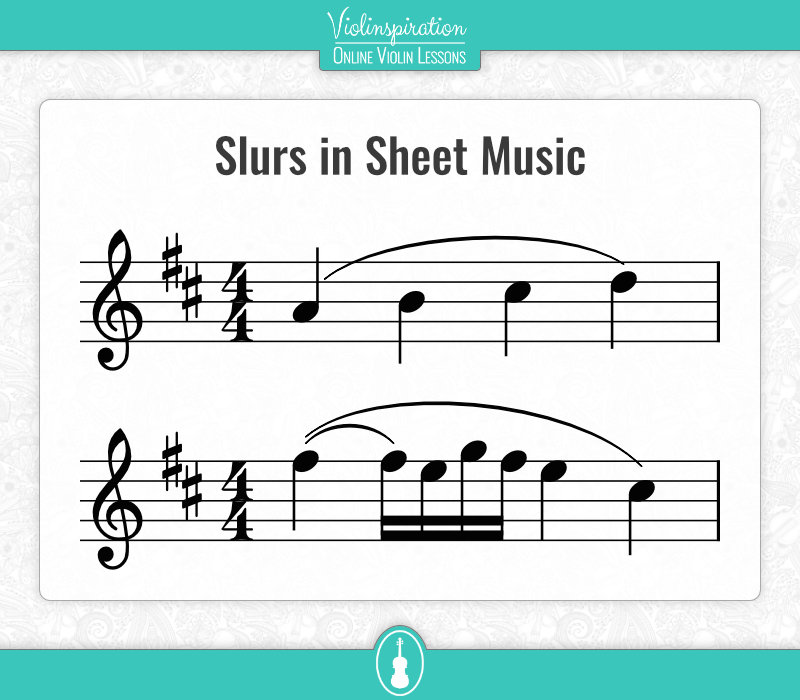
To learn more about it, check out my video about slurs over here – Julia’s Violin Academy members only.
Other Bow Markings
Some composers are very specific with what types of bow strokes they want to hear in their music. Because of this, there are about 25 different bowing techniques we can use on the violin. Learn more about these techniques, how they’re notated, and how to play them in my Violin Bowing Technique Guide.
What to Do if There is No Up Bow or Down Bow Indication?
If a piece is in 4/4 and begins on beat 1, we’ll almost always play that first beat on a down bow. If we see pickup notes, things can become more complicated. It’s helpful to map out how many bow strokes we’ll need to play before the next measure (the first full measure). We’ll want the first beat of that measure to fall down bow. Then work backward to see which bow direction you should begin with.
In a lot of sheet music, we won’t see any (or many) bowing directions. This means we have to decide which bow direction to use and when.
Did you know there’s actually a hierarchy of beats? Some beats in a measure are more important or stronger than others.
In a 4/4 measure, beat 1 is the most important and strongest. Beat 2 is usually weak, Beat 3 is strong, and beat 4 is the weakest.
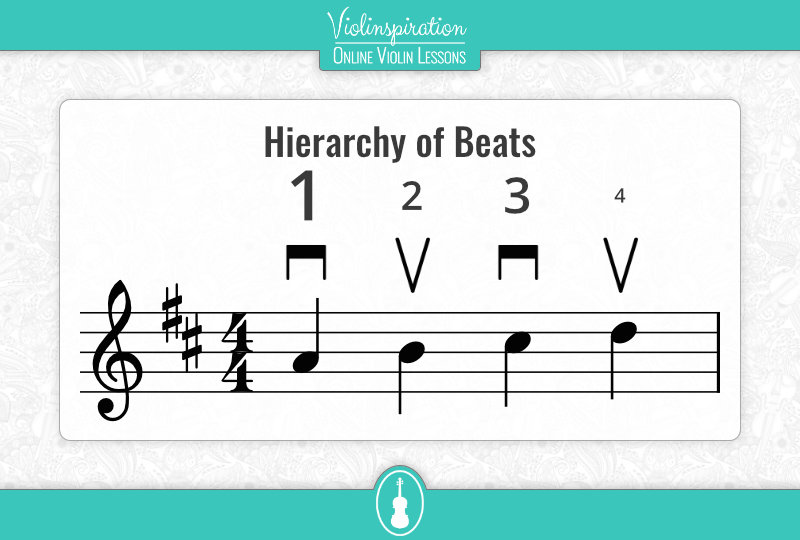
As violin players, we want to line up our down bows with the strong beats and our up bows with the weak beats. This means, if I wanted to play a 4/4 measure of quarter notes, I would start down bow and play “as it comes” (back and forth between bow directions) for the rest. Beat 1 is a down bow, beat 2 up bow, beat 3 is a down bow, and beat 4 is an up bow. It lines up with the hierarchy of beats.
How to Get Better at Bowing
Using the bow is such an important aspect of playing the violin. Our bows produce sound–all the sound–that we hear. Bowing is one of the most important things a string player should practice and get comfortable with.
Here are a few resources you can practice with to improve your bowing technique:
Playing with a straight bow
Playing with a straight bow will help you create a smoother and more consistent sound on the violin. We want to play with our bow parallel to the bridge to create the nicest sound.
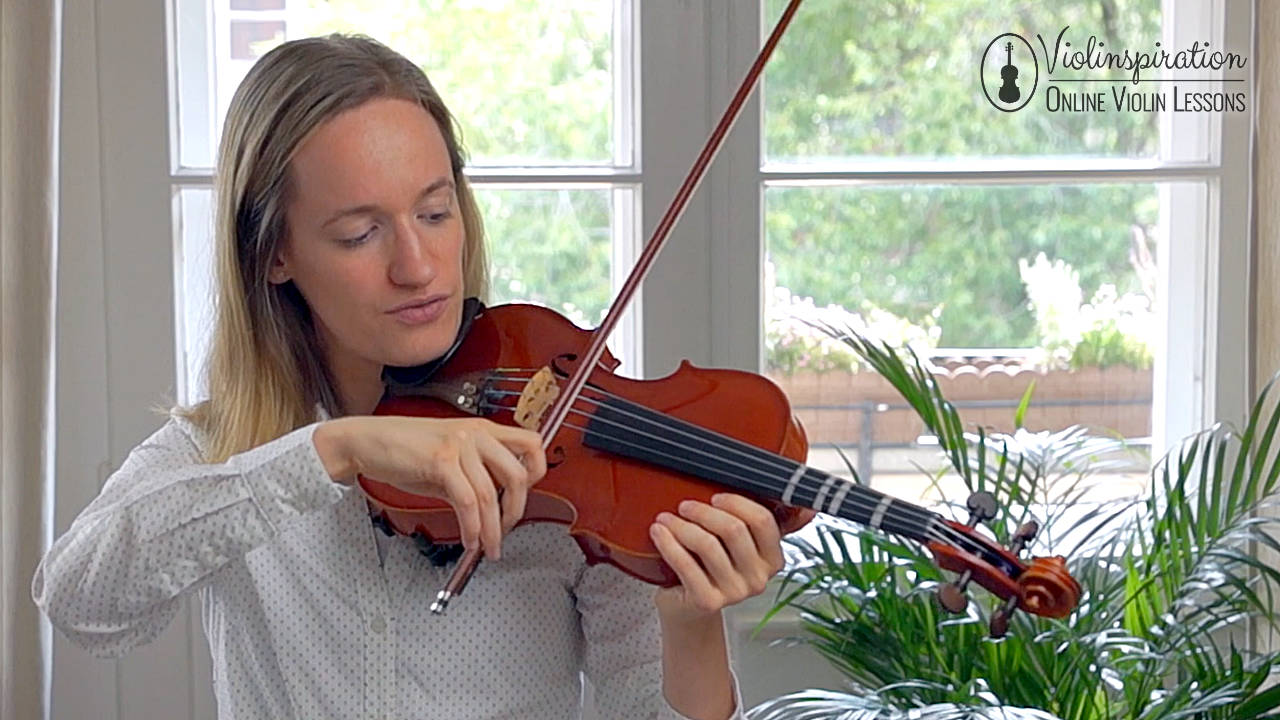
String crossings
Any “change” we make on the violin feels difficult. Whether that’s a rhythm that changes, a bow change, or a string crossing, you’ll notice these transitions are difficult. String crossings are one of the hardest techniques to solidify, even for professionals!
Releasing tension in your right hand
A lot of us hold tension in our bodies as we pay much attention to everything we’re trying to accomplish while playing the violin. However, the tension in your bow hand will result in “choppy” sounds, and you might also notice squeaking and shrieking sounds if you hold too much tension and use too much weight in your right hand and fingers.
Getting feedback on your bowing & bow hold
Yet another way to get better at bowing and your bow hold is to ask a teacher for a piece of advice. If you’re a student of Julia’s Violin Academy, record a video of yourself showing your bow hold, you can add playing your current piece or a scale, then submit it on the Academy page.
It might seem a bit scary at first to record yourself, but I truly hope that the benefit of getting direct tips based on your current playing level from an experienced violin teacher is worth it 🙂
Final Note
Using the bow is a huge aspect of string playing, and knowing the difference between down bows and up bows will help you create beautiful music.
Now that you know the difference between bow directions, you’ll have lots of new techniques to work on. Good luck practicing with a new focus on your right hand–I hope it makes a big improvement in your playing!
